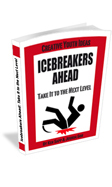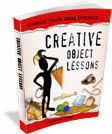Materials
Obtain a children’s puzzle of 10-20 large pieces. Alternatively, get a poster of a church or group of people and cut it into pieces for a puzzle. You can also draw pictures on a large piece of paper, then cut them up. If you are using a precut puzzle of a set number of pieces you may need to use an additional puzzle if the group is larger than the number of pieces. On the back of the pieces you can write questions about the church as icebreakers. Some possible questions are:
* What are some things we do at church?
* Why did Jesus set up the church?
* What is the most important thing that happens at church?
* Name the things you would find in a church?
* What is the difference between a church and a society or organization?
* Why do people go to church?
* Why is the church important?
Put one of the questions on the back of each piece of the puzzle. Repeat questions for larger groups. Remove the corners of the puzzle and write Jesus on the back of them. Mix up the pieces except for the corners. Use puzzle shaped nametags for participants for more fun!
Activity
As each person comes arrives give them a piece. Have them mingle among the group and find ONE person who has a piece of the puzzle that connects to theirs. When they find someone, they then ask each other the questions on the back of their pieces. After discussing the questions, they should move and find another person. Every piece of the puzzle will have at least 3 possible connections. (Corners have only 2 but are not used yet. Edge pieces have 3 connections and pieces from the center of the puzzle have 4)
After the group has mingled, give them the corners you have set aside, and have them construct the puzzle. Make the following rule: No one may touch any one else’s piece of the puzzle (i.e. you have to put your own pieces into the puzzle) If you have more than one puzzle you can have the groups compete to see who completes it the quickest. Do not show them the box with the picture of the completed puzzle.
Application
Ask the following question: How is the puzzle representative of the church – the Body of Christ? You can refer them to 1 Corinthians 12 if they are stuck. Write their responses on the white board. Some possible responses are:
1. made up of many parts.
2. Christ is the cornerstone
3. The parts fit together to make a whole
4. if one part is missing, the whole suffers – to be complete they need each other
5. no piece, is more important that the others.
6. some relationships are closer than others
7. together they form a picture
8. they didn’t have the box so it was sometimes difficult to know what they were forming
9. different people acted as leaders to help them form the picture
10. The pieces support each other
11. there are different connections – shapes – that connect each
12. each piece is different / unique
13. Each piece is identified by where it fits into the whole
14. Some pieces are easily identified but not more important
Closing
After this activity, ask each person to take back their piece of the puzzle as a reminder of the lessons of the puzzle.
Variation
Hide the pieces of the puzzle throughout classroom while children/ youth are out of the room. Have a card table or work area where the puzzle can be reassembled. Let youth / children have a scavenger hunt for the puzzle pieces. When a player finds a piece they are to bring it to the table to fit it together with the other pieces. When a person finds a piece, she/she must ask the question or answer the question on the back of the piece then place it into the puzzle. Once they have found where that piece goes they are off searching for another piece of the puzzle. At the end, have the participants think about all those pieces, each one a different shape, size and color but they all come together to become one big picture.
Find out how you can get 52 of my best icebreakers of all time! (That’s a full year of icebreakers – one a week!) They even lead into lessons on youth related issues!

This 170 page resource not only provides 52 of the world’s most popular group icebreaker activities and games, but also includes lesson ideas and discussion questions to smoothly transition into conversations about the issues common to most groups.
Click here to find out how to get your hands on this incredible resource!

 Icebreakers Ahead: Take It To the Next Level
Icebreakers Ahead: Take It To the Next Level
